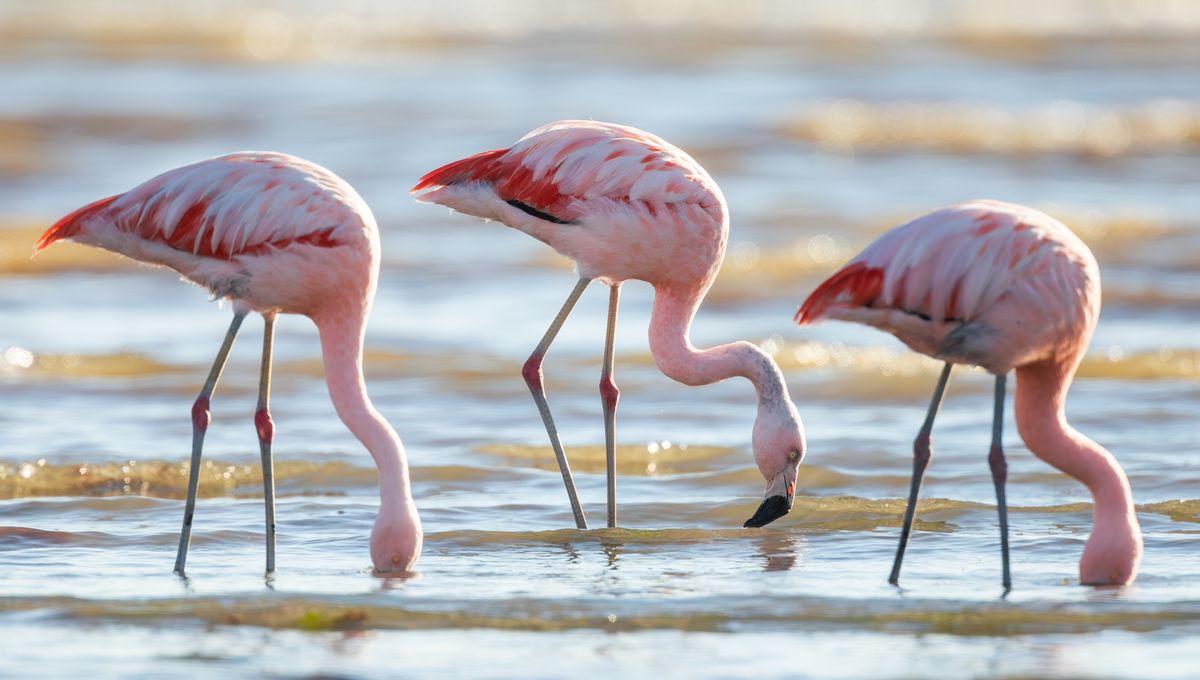
Flamingos Make Tiny Tornadoes In Water To Trap Their Prey
How did your country report this? Share your view in the comments.
Quick Summary:
- Dr Victor Ortega Jiménez of the University of California, Berkeley has led to an extensive quest to understand the feeding behavior of flamingos. The activity beneath the water line turns out to be remarkably complex. Could provide valuable tips for how humans could concentrate objects in water, such as microplastics for removal. Flamingos’ webbed feet squeeze out sediment vortices rich in food as they raise their feet. Spreading the feet on the downstroke and folding the webs on the up maximizes the effect.
- When flamingos stomp their feet, they generate tornado-like vortices that churn up small animals, such as brine shrimp, from the bottom. This vortex swirling around a vertical axis concentrates food particles at a speed of up to 1.3 feet per second. The findings are detailed in a study published this week in the journal Proceedings of the National Academy of Sciences. For more information on flamingos, visit flamingos.org.
- Flamingos use a repertoire of behaviours, including stomping feet, jerking heads, and chattering beaks, to create swirling ‘underwater tornadoes’ The team believes that their findings could be used to design better systems for concentrating and sucking up particles, such as microplastics. They also use a technique called ‘skimming’ which involves pushing the head forward while chattering to create sheet-like vortices.
Country-by-Country Breakdown:
Original Coverage
Dr Victor Ortega Jiménez of the University of California, Berkeley has led to an extensive quest to understand the feeding behavior of flamingos. The activity beneath the water line turns out to be remarkably complex. Could provide valuable tips for how humans could concentrate objects in water, such as microplastics for removal. Flamingos’ webbed feet squeeze out sediment vortices rich in food as they raise their feet. Spreading the feet on the downstroke and folding the webs on the up maximizes the effect. Read full article
Flamingos conjure ‘water tornadoes’ to trap their prey
When flamingos stomp their feet, they generate tornado-like vortices that churn up small animals, such as brine shrimp, from the bottom. This vortex swirling around a vertical axis concentrates food particles at a speed of up to 1.3 feet per second. The findings are detailed in a study published this week in the journal Proceedings of the National Academy of Sciences. For more information on flamingos, visit flamingos.org. Read full article
Watch flamingos create water tornadoes to trap their prey
Flamingos use a repertoire of behaviours, including stomping feet, jerking heads, and chattering beaks, to create swirling ‘underwater tornadoes’ The team believes that their findings could be used to design better systems for concentrating and sucking up particles, such as microplastics. They also use a technique called ‘skimming’ which involves pushing the head forward while chattering to create sheet-like vortices. Read full article
Flamingos dance, chatter, and make water tornadoes to catch prey
Chilean flamingos stir sediment with their webbed, floppy feet, generating spinning flows. By pulling their heads upward through the water, the birds lift these whorls to the surface. While submerged upside down, they rapidly chatter their angled beaks to create even finer vortexes. The birds are found in southern Chile and northern Argentina. For more information on the Chilean flamingo, visit www.chileanflamingo.org. Read full article
Flamingos Create Tiny Underwater Tornadoes To Trap Prey
Flamingos’ unique L-shaped beak has long confused scientists trying to understand its purpose. When a flamingo quickly pulls its head up from the bottom of a pond, it generates “tornado-like vortices” at speeds around 40 centimeters per second. Flamingos also use “asymmetric beak chattering,” a rapid opening and closing of their jaws underwater. Read full article
Global Perspectives Summary:
Global media portray this story through varied cultural, economic, and political filters. While some focus on geopolitical ramifications, others highlight local impacts and human stories. Some nations frame the story around diplomatic tensions and international relations, while others examine domestic implications, public sentiment, or humanitarian concerns. This diversity of coverage reflects how national perspectives, media freedom, and journalistic priorities influence what the public learns about global events.
How did your country report this? Share your view in the comments.
Sources:
- Original Article
- Flamingos conjure ‘water tornadoes’ to trap their prey
- Watch flamingos create water tornadoes to trap their prey
- Flamingos dance, chatter, and make water tornadoes to catch prey
- Flamingos Create Tiny Underwater Tornadoes To Trap Prey
Source: https://www.iflscience.com/flamingos-make-tiny-tornadoes-in-water-to-trap-their-prey-79194

